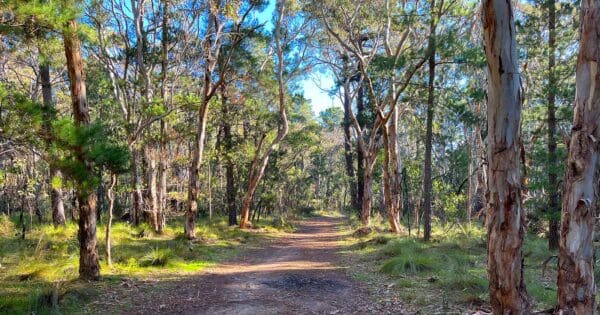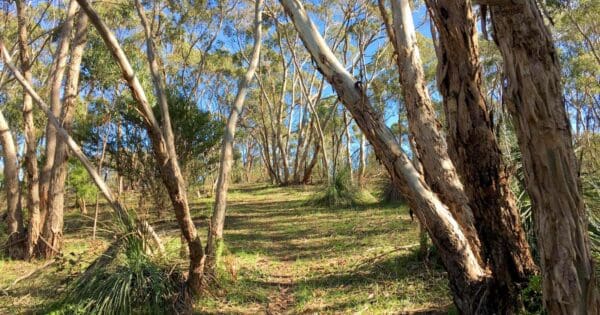Hike at a Glance
Max elevation: 371m
Min elevation: 298m
Total Ascent: 200m
Hike overview
The Onkeeta Circuit Walk is a 10.8-kilometre loop trail located within the northern section of Kuitpo Forest Reserve, South Australia. This moderately challenging (grade 3) track is ideal for walkers, cyclists, and horse riders, offering a scenic journey through the forest on designated trails and paths. The circuit typically takes around three hours to complete.
Hikers can begin the trail at the car park situated on Peters Creek Road at the junction of Knott Hill Road. Alternatively, access is also available from Brookman Connor Road. Whichever starting point you choose, the Onkeeta Circuit promises an immersive experience of the diverse flora and fauna of Kuitpo Forest. Keep an eye out for the endangered Yellow-tailed Black Cockatoo, a resident species in the area.
The Onkeeta Trail is well-marked and as a grade 3 track, it's considered a moderate hike suitable for bushwalkers with average fitness. These trails can vary in length and may include moderate inclines and uneven surfaces. For ease of navigation, the Onkeeta Circuit is equipped with map orientation plates, checkpoint markers, and trail markers throughout the route.
Track grade
Grade 3 (Moderate) - Walks for Most Fitness Levels: Grade 3 on the AWTGS represents moderate walking tracks. These are ideal for walkers with some fitness who are comfortable with some hills and uneven terrain. While suitable for most ages, some bushwalking experience is recommended to ensure a safe and enjoyable experience. Tracks may have short, steep hill sections, a rough surface, and many steps. The total distance of a Grade 3 walk can be up to 20 kilometers.
Walk map and GPX file
Max elevation: 371 m
Min elevation: 298 m
Total climbing: 200 m
Total descent: -200 m
Content use
Please don’t copy GPX files or content from this site to AllTrails or other platforms. Each trail has been personally mapped, documented, and refined to support Australia’s bushwalking and hiking community. While some details come from land managers, every listing reflects significant personal effort. This is a free, community-driven initiative—your respect helps keep it that way.
Gallery
Got any photos from this hike? Your photos can help others plan. Share shots from along the trail so fellow hikers know what to expect.
Click to add your photos >>
Getting there
Getting to the trailhead: Kuitpo Forest Reserve.
Kuitpo Forest Reserve is conveniently located within the South Mount Lofty Ranges, just a 45-minute drive from Adelaide. Nestled near the township of Meadows, the reserve offers easy access for visitors. Drivers travelling from Adelaide have two main route options. The first involves following the Main South Road before turning off towards Clarendon and Meadows. Alternatively, motorists can take the South Eastern Freeway towards Hahndorf and then turn off for Echunga and Meadows.
Need a rental car to get you to the hike? Find one here.
About the region
Nestled in the Mount Lofty Ranges on Kaurna and Peramangk Country, Kuitpo Forest Reserve boasts a rich history. Established in 1898 as the first of many sustainable timber plantations in South Australia, it encompasses 3,600 hectares today. Over 60% (2,100 hectares) is dedicated to plantations, while the remaining area serves vital conservation purposes and provides recreational opportunities for the community.
Kuitpo Forest Reserve forms part of ForestrySA's broader Mount Lofty Ranges forest estate and is managed with a focus on responsible forestry practices. This ensures the ongoing health of native flora and fauna while allowing for sustainable timber production. The reserve also prioritises community use, making it a popular destination for recreation.
Kuitpo's proximity to Adelaide, just a one-hour drive away, further contributes to its popularity. Hundreds of thousands of visitors flock to the reserve each year to camp, enjoy unique hut-style accommodation, explore the trails on foot or bike, or participate in organized community events. Horse riding is another popular activity within the reserve.
Walking, cycling, and horse riding enthusiasts will find plenty to explore at Kuitpo Forest. The network includes four shared-use trails catering to various user groups and one shorter walking/cycling trail ideal for a leisurely outing.
Find a place to stay
Wondering where to stay near this hike? Find accommodation close to the trailhead — hotels, cabins and campgrounds nearby. Click the button to view the interactive map.
Closest towns to this walk: Aldinga, Ashbourne, Clarendon, Hahndorf, Harrogate, Kangarilla, Kuitpo, Macclesfield, Meadows, Mount Compass, Willunga
Let someone know
Heading out? Fill in a trip intentions form so someone knows your plans. If things go wrong, they can raise the alarm fast, giving you peace of mind on the trail.
Similar walks nearby
Looking for more walks in or near Kuitpo Forest Reserve? Try these trails with a similar difficulty grade.
Suggest an edit
Notice something different about this trail? Whether it’s a new feature, a route change, or a closure, share your update so we can keep our info accurate and helpful for fellow hikers.
Click to suggest edits >>
Explore safe
Plan ahead and hike safely! Carry enough water, pack layers for changing conditions, and bring safety gear like a torch, PLB, and reliable communication device. Check official sources for trail updates, closures, and access requirements, and review local weather and bushfire advice. Most importantly, share your plans with someone before you go. Being prepared makes for a safer and more enjoyable hike! Stay Safe, Explore More, and Always #ExploreSafe.
Packing checklists
What you carry in your pack depends on factors like weather, terrain, and your adventure type. Not sure what to bring? My free planning, food, and packing checklists are a great starting point, covering day hikes, overnight trips, and multi-day adventures. Use them to customise your kit and always prioritise safety.
Acknowledgement of Country
Trail Hiking Australia acknowledges the Traditional Owners of the lands on which we hike and pay respects to their Elders, past and present, and we acknowledge the First Nations people of other communities who may be here today.






